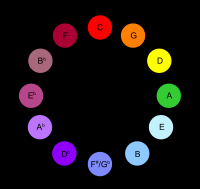- Clavier à lumières
-
The clavier à lumières (keyboard with lights), or tastiéra per luce, as it appears in the score, was a musical instrument invented by Alexander Scriabin for use in his work Prometheus: Poem of Fire. However, only one version of this instrument was constructed, for the performance of Prometheus: Poem of Fire in New York in 1915.[1] The instrument was supposed to be a keyboard, with notes corresponding to colors as given by Scriabin's synesthetic system, specified in the score,[2] though it's doubted that Scriabin was a synesthete [3] .[4]
The "Luce" part is notated on a treble staff with two parts, one proceeding on the circle of fifths during the piece, the other following the tonal centre of the music.
Scriabin assigned the following colors to the following key areas:
By chromatic scale Note Colour C red (intense) C# violet or purple D yellow D# flesh (glint of steel) E sky blue (moonshine or frost) F deep red F# bright blue or violet G orange G# violet or lilac A green A# rose or steel B blue or pearly plue When the notes are ordered by the circle of fifths, the colours are in order of a spectrum, which some scholars believe indicates[dubious ] that he did not experience the physiological condition of synesthesia, and that it was a thought out system that was influenced by his theosophic readings and based on Sir Isaac Newton's Optics:
By spectrum Colour Note deep red F red C orange G yellow D green A sky blue E blue B bright blue F# violet or purple C# lilac G# flesh D# rose A# Scriabin was a friend of Nikolai Rimsky-Korsakov, who was also a synesthete. Scriabin's assignments of colours to keys was not the same as Rimsky-Korsakov's perceptions, which is not an indication that Scriabin was not a synesthete as all synesthetes perceive different associations. Scriabin was also heavily influenced by Theosophy, which had its own different system of associating colors and pitches (in essence going up the visible spectrum from C to B chromatically, rather than by fifths).
Contents
See also
- Color organ
- Visual music
- Music visualization
- New Epoch Notation Painting
- List of people with synesthesia
References
- ^ Henry Chapin Plummer, "Colour Music-A New Art Created With the Aid of Science: The Colour Organ Used in Scriabine's Symphony Prometheus," Scientific American, (April, 1915) Plummer describes in detail the design and technology used to produce the instrument for the colour effect prescribed by Scriabin.
- ^ Cummings, Robert. "Symphony No. 5 in F sharp major for piano, organ, chorus & orchestra ("Prometheus, Poem of Fire"), Op. 60": "in the score he specifies that certain colors should flood the concert hall during performance".
- ^ *Harrison, John (2001). Synaesthesia: The Strangest Thing, ISBN 0192632450: "In fact, there is considerable doubt about the legitimacy of Scriabin's claim, or rather the claims made on his behalf, as we shall discuss in Chapter 5." (p.31-2).
- ^ B. M. Galeyev and I. L. Vanechkina (August 2001). "Was Scriabin a Synesthete?", Leonardo, Vol. 34, Issue 4, pp. 357 - 362: "authors conclude that the nature of Scriabin’s 'color-tonal' analogies was associative, i.e. psychological; accordingly, the existing belief that Scriabin was a distinctive, unique 'synesthete' who really saw the sounds of music—that is, literally had an ability for 'co-sensations'— is placed in doubt."
External links
- RhythmicLight.com
- Visual Music A history of Color Organs, various mappings of tones to colors (including Scriabin's), and other representations of music in art. Has many external links.
Further reading
- Alexander Scriabin's Prometheus: Philosophy and Structure by Kenneth John Peacock. 1976 PhD Dissertation at the University of Michigan.
Categories:- Keyboard instruments
- Visual music
Wikimedia Foundation. 2010.


